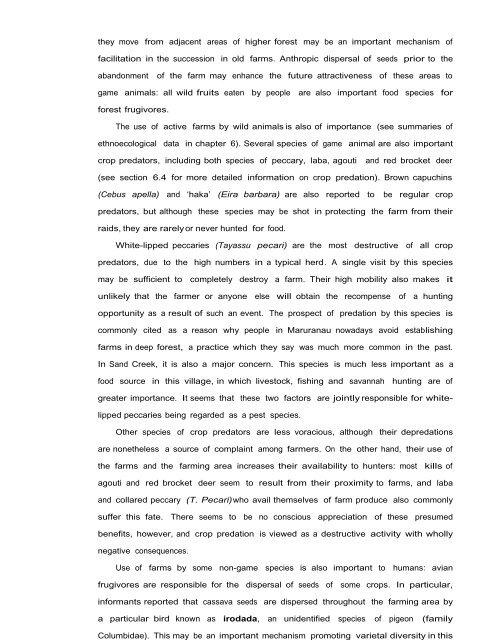Ethnoecology, Resource Use, Conservation And Development In A ...
Ethnoecology, Resource Use, Conservation And Development In A ...
Ethnoecology, Resource Use, Conservation And Development In A ...
Create successful ePaper yourself
Turn your PDF publications into a flip-book with our unique Google optimized e-Paper software.
they move from adjacent areas of higher forest may be an important mechanism of<br />
facilitation in the succession in old farms. Anthropic dispersal of seeds prior to the<br />
abandonment of the farm may enhance the future attractiveness of these areas to<br />
game animals: all wild fruits eaten by people are also important food species for<br />
forest frugivores.<br />
The use of active farms by wild animals is also of importance (see summaries of<br />
ethnoecological data in chapter 6). Several species of game animal are also important<br />
crop predators, including both species of peccary, laba, agouti and red brocket deer<br />
(see section 6.4 for more detailed information on crop predation). Brown capuchins<br />
(Cebus apella) and ‘haka’ (Eira barbara) are also reported to be regular crop<br />
predators, but although these species may be shot in protecting the farm from their<br />
raids, they are rarely or never hunted for food.<br />
White-lipped peccaries (Tayassu pecari) are the most destructive of all crop<br />
predators, due to the high numbers in a typical herd. A single visit by this species<br />
may be sufficient to completely destroy a farm. Their high mobility also makes it<br />
unlikely that the farmer or anyone else will obtain the recompense of a hunting<br />
opportunity as a result of such an event. The prospect of predation by this species is<br />
commonly cited as a reason why people in Maruranau nowadays avoid establishing<br />
farms in deep forest, a practice which they say was much more common in the past.<br />
<strong>In</strong> Sand Creek, it is also a major concern. This species is much less important as a<br />
food source in this village, in which livestock, fishing and savannah hunting are of<br />
greater importance. It seems that these two factors are jointly responsible for white-<br />
lipped peccaries being regarded as a pest species.<br />
Other species of crop predators are less voracious, although their depredations<br />
are nonetheless a source of complaint among farmers. On the other hand, their use of<br />
the farms and the farming area increases their availability to hunters: most kills of<br />
agouti and red brocket deer seem to result from their proximity to farms, and laba<br />
and collared peccary (T. Pecari) who avail themselves of farm produce also commonly<br />
suffer this fate. There seems to be no conscious appreciation of these presumed<br />
benefits, however, and crop predation is viewed as a destructive activity with wholly<br />
negative consequences.<br />
<strong>Use</strong> of farms by some non-game species is also important to humans: avian<br />
frugivores are responsible for the dispersal of seeds of some crops. <strong>In</strong> particular,<br />
informants reported that cassava seeds are dispersed throughout the farming area by<br />
a particular bird known as irodada, an unidentified species of pigeon (family<br />
Columbidae). This may be an important mechanism promoting varietal diversity in this


